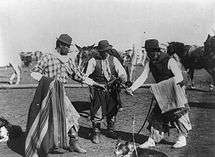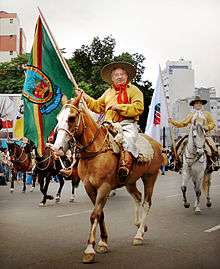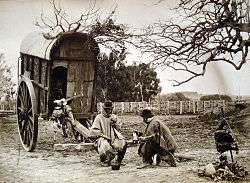Gaucho
Gaucho (Spanish: [ˈɡautʃo]) or gaúcho (Portuguese: [ɡaˈuʃo]) is a word with several meanings. In its historical sense a gaucho was one "who, in the 18th and 19th centuries, inhabited Argentina, Uruguay and Rio Grande do Sul.[1] Today, in Argentina and Uruguay, a gaucho is simply "A country person, experienced in traditional cattle ranching work".[2] Because historical gauchos were reputed to be brave, if unruly, the word is also applied metaphorically to mean "Noble, brave and generous",[3] but also "One who is skilful in subtle tricks, crafty".[4] In Portuguese the word gaúcho (note the accent) means "An inhabitant of the plains of Rio Grande do Sul or the pampas of Argentina descended from European man and [Amer]Indian woman who devotes himself to lassoing and raising cattle and horses";[5] and in Brazil gaúcho has also acquired a metonymic signification, meaning anyone, even an urban dweller, who is a citizen of the State of Rio Grande do Sul.[6] In its purest sense, gaucho referred to the nomadic, often outlaw inhabitants of the great plains of Argentina, Uruguay and Brazil. In current usage, gaucho usually designates the rural working class in general."[7]
The gaucho in some respects resembled members of other nineteenth century rural, horse-based cultures such as the North American cowboy (vaquero, in Spanish), the Chilean huaso, the Venezuelan or Colombian llanero, the Hawaiian paniolo,[8] and the Mexican charro.
The gaucho is a national symbol in both Argentina and Uruguay. Gauchos became greatly admired and renowned in legends, folklore and literature and became an important part of their regional cultural tradition. Beginning late in the 19th century, after the heyday of the gauchos, they were celebrated by South American writers.
Etymology

There are several hypotheses concerning the origin of the term. It may derive from the Spanish term chaucho (in turn derived from Arabic chauia which means herdsman). The first recorded use of the term dates to Argentine independence in 1816. Another scenario indicates the word may derive from the Portuguese gaudério, which was designated to the inhabitants of the vast regions of Rio Grande do Sul and Río de la Plata in the 18th century or the Portuguese garrucho that points to an instrument used by the gauchos to trap and hamstring cattle. The 18th century chronicler Alonso Carrió de la Vandera speaks of "Gauderios" when it mentions the Gauchos or "Huasos" as poorly dressed men.
Essential attribute: the horse
An essential attribute of a gaucho was that he was a skilled horseman. Without a horse the gaucho felt himself unmanned. A gaucho could ride as soon as he could walk. The naturalist William Henry Hudson (who was born on the pampas of Buenos Aires province) recorded that the gauchos of his childhood used to say, a man without a horse was a man without legs.[9] He described meeting a blind gaucho who was obliged to beg for his food yet behaved with dignity and went about on horseback.[10] Richard W. Slatta, the author of a scholarly[11] work about gauchos, notes that the gaucho used horses to collect, mark, drive or tame cattle; to draw fishing nets; to hunt ostriches; to snare partridges; to draw well water; and even − with the help of his friends − to ride to his own burial.[12]
By reputation the quintessential gaucho caudillo Juan Manuel de Rosas could throw his hat on the ground and scoop it up while galloping his horse, without touching the saddle with his hand.[13]For the gaucho, the horse was absolutely essential to his survival for, said Hudson: "he must every day traverse vast distances, see quickly, judge rapidly, be ready at all times to encounter hunger and fatigue, violent changes of temperature, great and sudden perils".[14]
A popular copla was:
- Mi caballo y mi mujer
- viajaron para Salta,
- el caballo que se vuelva,
- mi mujer que no me hace falta.[15]
- ("My horse and my woman/Went off to Salta/May the horse return/For I don't need my woman.")
It was the gaucho's passion to own all his steeds in matching colours. Recalled Hudson:
The gaucho, from the poorest worker on horseback to the largest owner of lands and cattle, has, or had in those days, a fancy for having all his riding-horses of one colour. Every man as a rule had his tropilla — his own half a dozen or a dozen or more saddle-horses, and he would have them all as nearly alike as possible, so that one man had chestnuts, another browns, bays, silver- or iron-greys, duns, fawns, cream-noses, or blacks, or whites, or piebalds.[16]
The caudillo El Chacho Peñalosa described the low point of his life as "In Chile − and on foot!" (En Chile y a pie.)[17]
Culture

The gaucho plays an important symbolic role in the nationalist feelings of this region, especially that of Argentina, Paraguay, and Uruguay. The epic poem Martín Fierro by José Hernández (considered by some[18] the national epic of Argentina) used the gaucho as a symbol against corruption and of Argentine national tradition, pitted against Europeanising tendencies. Martín Fierro, the hero of the poem, is drafted into the Argentine military for a border war, deserts, and becomes an outlaw and fugitive. The image of the free gaucho is often contrasted to the slaves who worked the northern Brazilian lands. Further literary descriptions are found in Ricardo Güiraldes' Don Segundo Sombra. Like the North American cowboys, as discussed in Richard W. Slatta, Cowboys of the Americas, gauchos were generally reputed to be strong, honest, silent types, but proud and capable of violence when provoked. The gaucho tendency to violence over petty matters is also recognized as a typical trait. Gauchos' use of the famous "facón" (large knife generally tucked into the rear of the gaucho sash) is legendary, often associated with considerable bloodletting. Historically, the facón was typically the only eating instrument that a gaucho carried.
Also like the cowboy, as shown in Richard W. Slatta, Cowboys of the Americas, gauchos were and remain proud and great horseriders. Typically, a gaucho's horse constituted most of what he owned in the world. During the wars of the 19th century in the Southern Cone, the cavalries on all sides were composed almost entirely of gauchos. In Argentina, gaucho armies such as that of Martín Miguel de Güemes, slowed Spanish advances. Furthermore, many caudillos relied on gaucho armies to control the Argentine provinces.
The gaucho diet was composed almost entirely of beef while on the range, supplemented by yerba mate (erva mate in Portuguese), an herbal infusion made from the leaves of a South American tree, a type of holly rich in caffeine and nutrients.
Gauchos[19] dressed quite distinctly from North American cowboys, and used bolas or boleadoras - in Portuguese boleadeiras - (three leather bound rocks tied together with approximately three feet long leather straps) in addition to the familiar "North American" lariat or riata. The typical gaucho outfit would include a poncho (which doubled as a saddle blanket and as sleeping gear), a facón (large knife), a rebenque (leather whip), and loose-fitting trousers called bombachas, belted with a tirador, or a chiripá, a loincloth. During winters, gauchos wore heavy wool ponchos to protect against cold.
Modern influences
Gaúcho is also the common denomination of the current inhabitants of the Brazilian State of Rio Grande do Sul.
Gauchito (a boy in the Argentine colors and a gaucho hat) was the mascot for the 1978 FIFA World Cup.
In popular culture
- Way of a Gaucho 1952 film starring Gene Tierney and Rory Calhoun.
- The Gaucho was a 1927 film starring Douglas Fairbanks.
- La Guerra Gaucha was a 1942 Argentine film set during the Gaucho war against Spanish royalists in Salta, northern Argentina, in 1817. It is considered a classic of Argentine cinema.
- The third segment of Disney's 1942 animated feature package film, Saludos Amigos, is titled "El Gaucho Goofy", where American cowboy Goofy gets taken mysteriously to the Argentine pampas to learn the ways of the native gaucho.
- Gaucho is the name of the 1980 album by American jazz fusion band Steely Dan, which featured a song by the same name.
- Gauchos of El Dorado was a 1941 American Western "Three Mesquiteers" B-movie directed by Lester Orlebeck.
Gallery
 Gaucho in authentic clothing, 1840s.
Gaucho in authentic clothing, 1840s. Argentine Pampas gauchos training for the Esgrima Criolla.
Argentine Pampas gauchos training for the Esgrima Criolla. Un alto en el campo (1861) by Prilidiano Pueyrredon.
Un alto en el campo (1861) by Prilidiano Pueyrredon. Chilean gauchos, 1820s.
Chilean gauchos, 1820s. La Posta de San Luis by Juan León Pallière (1858).
La Posta de San Luis by Juan León Pallière (1858). Two gauchos in Buenos Aires, Argentina, in 1880.
Two gauchos in Buenos Aires, Argentina, in 1880..jpg) Folklore dance: Zamba, Argentina. Gaucho.
Folklore dance: Zamba, Argentina. Gaucho.- Emperor Pedro II of Brazil in typical Gaúcho outfit.
 Gauchos in Corrientes province, Argentina.
Gauchos in Corrientes province, Argentina. A Gaucho payador.
A Gaucho payador. Brazilian gaúcho with typical clothing at the 2006 Farroupilha Parade.
Brazilian gaúcho with typical clothing at the 2006 Farroupilha Parade. Argentine gauchos in the city of Salta.
Argentine gauchos in the city of Salta. Gauchos in the Federalist Revolution (1893 to 1895).
Gauchos in the Federalist Revolution (1893 to 1895).
See also
References
- ↑ Dictionary of the Royal Spanish Academy, Gaucho, sense 5.
- ↑ Dictionary of the Royal Spanish Academy, Gaucho, sense 6.
- ↑ Dictionary of the Royal Spanish Academy, Gaucho, sense 1.
- ↑ Dictionary of the Royal Spanish Academy, Gaucho, sense 4.
- ↑ Dicionário Priberam da Língua Portuguesa, Gaúcho.
- ↑ Oliven, Ruben George (2000). ""The Largest Popular Culture Movement in the Western World": Intellectuals and Gaúcho Traditionalism in Brazil". American Ethnologist. Wiley for the American Anthropological Association. 21 (1): 128–146. JSTOR 647129., p.129.
- ↑ Shumway, 12.
- ↑ Slatta, Auld and Melrose.
- ↑ Hudson, 1918, p. 23.
- ↑ Hudson, 1918, p. 24.
- ↑ The work has been peer-reviewed by Adelman, 1993; Collier, 1988; Lynch, 1984; Reber, 1984.
- ↑ Slatta, pp. 25-27.
- ↑ Cunninghame Graham, 1914, p. 5.
- ↑ Hudson, 1895, p. 356.
- ↑ Arnoldi and Hernández, p. 177.
- ↑ Hudson, 1918, p. 160.
- ↑ Sarmiento, p. 14.
- ↑ Leopoldo Lugones 1 in "El Payador" (1916)2 and Ricardo Rojas 3 established the canonical view regarding the Martín Fierro as the National Epic of Argentina. The consequences of these considerations are discussed by Jorge Luis Borges in his essay "El Martín Fierro". An assessment of the years-long discussion here, since p. 18
- ↑ South-images.com Photos: gauchos in Argentina, Photo library South-Images
Bibliography
- Adelman, Jeremy (May 1993). Review. Journal of Latin American Studies. 25. Cambridge University Press. pp. 410–2. JSTOR 158174.
- Arnoldi, Henry; Hernández, Isabel (1986). Amor tirano: antología del cancionero tradicional amoroso de Argentina. Ediciones del Sol. ISBN 9789509413030.
- Assunção, Fernando O. (2006). Historia del gaucho (in Spanish). Claridad. ISBN 978-950-620-205-7.
- Assunção, Fernando O. (1997). Pilchas criollas (in Spanish). Emecé. ISBN 950-04-1121-0.
- Collier, Simon (May 1998). Review. Journal of Latin American Studies. 20. Cambridge University Press. pp. 208–210.
- Cunninghame Graham, Robert Bontine (1914). El Río de la Plata (in Spanish). Londres: Wertheimer, Lea y Cía.
- Hudson, William Henry (1895). The Naturalist in La Plata. London: Chapman & Hall.
- Hudson, William Henry (1918). Far Away and Long Ago: A History of My Early Life. New York: E.P. Dutton and Company.
- Lynch, John (August 1984). Review. The Hispanic American Historical Review. 64. Duke University Press. pp. 586–7. JSTOR 2514963.
- Oliven, Ruben George (2000). ""The Largest Popular Culture Movement in the Western World": Intellectuals and Gaúcho Traditionalism in Brazil". American Ethnologist. Wiley for the American Anthropological Association. 21 (1): 128–146. JSTOR 647129.
- Reber, Vera Blinn (July 1984). Review. The Americas. 41. Cambridge University Press. pp. 140–1. JSTOR 1006958.
- Sarmiento, Domingo Faustino (2008). El chacho. Lingkua Digital. ISBN 9788498973518.
- Slatta, Richard W. (1992). Gauchos & the Vanishing Frontier. Lincoln and London: University of Nebraska Press. ISBN 0-8032-9215-5.
- Slatta, Richard W.; Auld, Ku'ulani; Melrose, Maile (2004). Cradle of Hawai'i's Paniolo. Montana: The Magazine of Western History. 54. Montana Historical Society. pp. 2–19. JSTOR 4520605.
- Shumway, Nicolas (1993). The Invention of Argentina. Berkeley; Los Angeles; London: University of California Press. ISBN 978-0-520-08284-7.
External links
| Wikimedia Commons has media related to Gauchos. |
- (Spanish) Tierra de Gauchos, Land of gauchos
- (Spanish) Confederacion Gaucha Argentina
- (Spanish) Folklore del Norte Argentino
- (Portuguese) Movimento Tradicionalista Gaúcho
- (Portuguese) Página do Gaúcho
- Aldo Sessas – Gauchos
- Richard W. Slatta – Gauchos and the Vanishing Frontier
- Richard W. Slatta – Cowboys of the Americas
- The Gauchos- Horsemen of the Pampas
- The Gaucho Tradition
- Cowboys in the city - Buenos Aires's gaucho market - video
- site of Gauchos and traditional estancias

